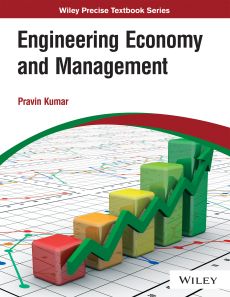Engineering Economy and Management
ISBN: 9788126579921
516 pages
Publication Year: 2019
eBook also available for institutional users
For more information write to us at: acadmktg@wiley.com

Description
Engineering Economy and Management highlights the importance of economics and management in engineering and helps engineers in managerial decision making. It provides comprehensive coverage of the subject from basic principles to state-of-the-art concepts and applications. This book is common to all students in engineering discipline and is very useful in evaluating the economic merits and demerits of various solutions to engineering problems. Engineering problems may involve the decisions related to resources and their allocation. Engineering economics is closely associated with conventional microeconomics; but here, its focus is on problem solving at operational levels.
Preface
About the Author
Chapter 1 Introduction to Engineering Economics
1.1 Introduction
1.2 Concept of Efficiency
1.3 Theory of Demand
1.4 Elasticity of Demand
1.5 Supply and Law of Supply
1.6 Indifference Curves
1.7 Budget Line
1.8 Welfare Analysis
Chapter 2 Managerial Economics
2.1 Introduction
2.2 Scope of Managerial Economics
2.3 Techniques of Managerial Economics
2.4 Applications of Managerial Economics
Chapter 3 Money, National Income, and Goods and Services Tax
3.1 Money
3.2 National Income
3.3 Goods and Services Tax
Chapter 4 Poverty, Unemployment, and Inflation
4.1 Scarcity
4.2 Poverty
4.3 Unemployment
4.4 Inflation
Chapter 5 Banking Systems
5.1 Introduction to Banking Systems
5.2 Types of Banks
5.3 Quantitative Instruments for Credit Control
5.4 Types of Banking
Chapter 6 Market Structures
6.1 Introduction
6.2 Perfect Competition
6.3 Monopoly
6.4 Monopolistic Competition
6.5 Oligopoly
6.6 Duopoly
6.7 Monopsony
6.8 Monopoly and Monopsony: A Comparison
Chapter 7 Marketing Management
7.1 Introduction
7.2 Marketing Mix
7.3 Market Segmentation
7.4 Exchange and Transactions
7.5 Marketing Research
7.6 Scope of Marketing
7.7 Product Life Cycle
7.8 Demand Forecasting
Chapter 8 Concepts in Management
8.1 Introduction
8.2 Characteristics of Management
8.3 Scope of Management
8.4 Classical School of Management
8.5 Functions of Management
8.6 Levels of Management
8.7 Skills of Management
8.8 Managerial Roles
8.9 Administration and Management
Chapter 9 Human Resource Management
9.1 Human Resource Management
9.2 Human Resource Planning
9.3 Recruitment and Selection
9.4 Job Design
9.5 Merit Rating
Chapter 10 Corporate Social Responsibility and Business Ethics
10.1 Corporate Social Responsibility
10.2 Types of Corporate Social Responsibilities
10.3 Ethics
Chapter 11 Production and Operations Management
11.1 Production and Operations Management
11.2 Objectives of Production Management
11.3 Production Systems
11.4 Facility Location
11.5 Plant Layout
Chapter 12 Demand Forecasting and Cost Estimation
12.1 Introduction
12.2 Forecasting Horizons
12.3 Steps to Forecasting
12.4 Forecasting Methods
12.5 Seasonal Adjustments
12.6 Forecasting Performance Measures
12.7 Cost Estimation
12.8 Elements of Cost
12.9 Computation of Material Variances
12.10 Break-Even Analysis
Chapter 13 Time Value of Money
13.1 Introduction
13.2 Simple Interest
13.3 Compound Interest
13.4 Present Worth Analysis
13.5 Future Worth Analysis
13.6 Annual Cash Flow Analysis
13.7 Rate of Return Analysis
13.8 Arithmetic Gradient
13.9 Geometric Gradient
13.10 Continuous Compounding
13.11 Normal and Effective Interest Rate
13.12 Perpetual Payment
Chapter 14 Project Evaluation
14.1 Introduction
14.2 Determining Minimum Attractive Rate of Return
14.3 Payback (Payout) Period Method
14.4 Benefit–Cost Ratio
Chapter 15 Comparison Among Alternatives
15.1 Introduction
15.2 Basis for Comparison of Alternatives
15.3 Study Period
15.4 Useful Lives of Alternatives Are Equal to the Study Period
15.5 Useful Lives of Alternatives Are Unequal
15.6 B–C Ratio Method for Comparison of Alternatives
Chapter 16 Depreciation and Taxes
16.1 Introduction
16.2 Some Important Terms Used in Depreciation
16.3 Classical Depreciation Methods
16.4 Modified Accelerated Cost Recovery System
16.5 Taxes
Chapter 17 Replacement Analysis
17.1 Introduction
17.2 Reasons for Replacement Analysis
17.3 Lives of Assets
17.4 Determining the Economic Life of a Challenger
17.5 Determining the Economic Life of a Defender
17.6 After-Tax Replacement Studies
Chapter 18 Concept of Financial Statement
18.1 Introduction
18.2 Sources of Company Information
18.3 Sources of International Economic Data
18.4 Financial Analysis
18.5 Financial Statement
18.6 Trading Account
18.7 Profit and Loss Account
18.8 Balance Sheet Requirements
18.9 Distinction between Profit and Loss Account and Balance Sheet
Chapter 19 Financial Ratios
19.1 Introduction
19.2 Types of Financial Ratios
19.3 Advantages and Limitations of Ratio Analysis
Chapter 20 Capital Budgeting
20.1 Introduction
20.2 Capital Financing and Allocation Functions
20.3 Sources of Capital Funds
20.4 Capital Asset Pricing Model
20.5 Weighted Average Cost of Capital
20.6 Leasing Decisions
20.7 Capital Allocation
Chapter 21 Decision Making
21.1 Introduction
21.2 Types of Decision-Making Environments
21.3 Decision Tree Analysis
21.4 Multiple Criteria Decision Making
Summary
Points to Remember
Multiple-Choice Questions
State whether True/False
Fill in the Blanks
Review Questions
Exercises
Appendix A
Statistical Tables and Procedures
Appendix B End-of-Period Compound Interest Tables
Appendix C Answers to Objective Type Questions
Bibliography
Index

